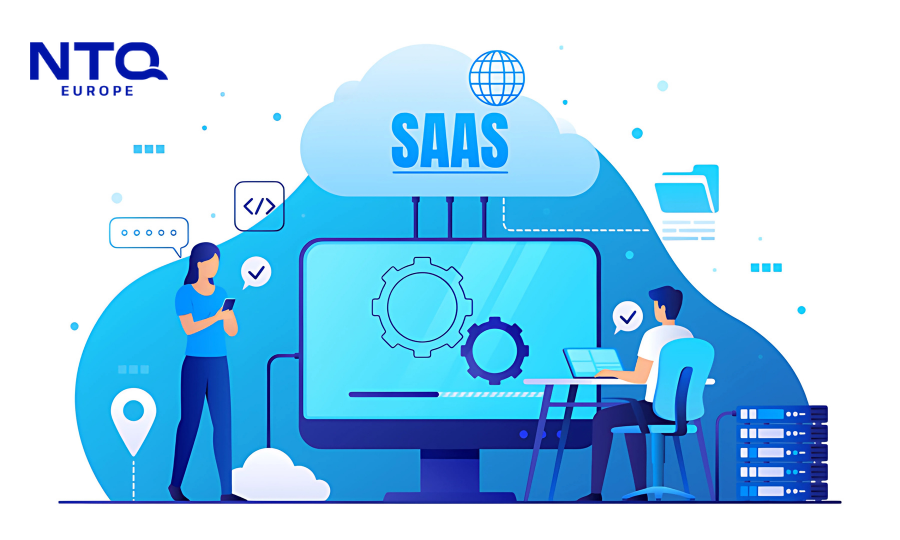1. Introduction to Cloud Migration
Cloud migration has become a strategic step for scalable infrastructure, business growth, and delivery speed.
Cloud migration is the transition of digital assets such as data, applications, and IT processes from on-premises infrastructure to a cloud-based environment. It can also include shifting workloads between different cloud platforms.
Why Move to the Cloud?
Embracing cloud migration allows businesses, regardless of size or sector, to drive innovation, improve efficiency, and support sustainable growth:
- Operational Agility: Respond to market demands faster.
- Scalability: Scale infrastructure up or down with minimal effort.
- Cost Efficiency: Reduce the costs of maintaining physical data centers.
- Security and Resilience: Integrate robust security measures, including encryption,multi-factor authentication (MFA), and regular security audits
- Remote Access: Allow access to resources and centrally manage from anywhere.

Common Cloud Deployment Models
- Public Cloud: Offered by providers like AWS, Microsoft Azure, and Google Cloud, public clouds provide shared resources and infrastructure on a subscription basis.
- Private Cloud: Hosted privately for a single organization, either on-site or by a third-party provider.
- Hybrid Cloud: Combine public and private cloud models to store, manage, and process data and applications, allowing businesses to use public cloud computing technology for less sensitive tasks and leverage private cloud computing technology for tasks that require high privacy and security.
2. Key Aspects of Cloud Migration
A successful cloud migration strategy requires accurate assessments, a comprehensive plan and a forward-thinking approach.
Assessing the Existing Infrastructure
To assess the current infrastructure, your business should analyze system dependencies, understand workload patterns, identify performance bottlenecks, and clarify compliance requirements.
Building a Cloud Migration Roadmap
A structured cloud migration strategy often involves the following:
- Assessment phase: Identify applications suitable for migration
- Planning phase: Define scope, resources, timelines, and responsibilities
- Pilot phase: Migrate a small, low-risk application as a test case
- Full migration: Execute in phases, prioritizing mission-critical systems.
- Optimization phase: Tune performance and cost post-migration
Creating a phased approach helps prevent disruption and allows businesses to adapt as needed.
Ensuring Data Security and Compliance
Security is often one of the biggest concerns during cloud transitions. A robust security strategy should include:
- Data encryption in transit and at rest
- Identity and access management (IAM)
- Regular security audits and penetration testing
- Compliance with GDPR, ISO, SOC 2, and other applicable standards
When done right, moving to the cloud can actually improve your security posture.
Cloud Cost Optimization
One of the overlooked aspects of cloud migration services is cost optimization. While the cloud offers flexibility, it can become costly if not managed properly.
To optimize cost, your business should rightsize instances, turn off unused resources, utilize reserved instances or spot pricing, and monitor usage with dashboards and alerts.
By integrating these controls early in your cloud migration strategy, you prevent waste and align spending with actual business value.
System Integration and Automation
When moving to the cloud, you should consider how your new systems will integrate into your existing infrastructure and daily operations. To ensure a seamless cloud migration process, you should employ APIs, utilize automation scripts, and orchestration tools like Terraform or Kubernetes.
3. Cloud Migration Strategies
To make your shift to the cloud a success, choosing the right cloud migration strategy is key. Businesses typically choose from several methods, frequently known as the “6 R’s of Cloud Migration.” What works best often depends on their specific requirements, the technical hurdles, and available resources. Among these, the most popular models are:
Rehosting (Lift and Shift)
Rehosting involves moving applications to the cloud with minimal or no changes. It’s often the fastest and least disruptive approach.
- Best suited for: Legacy systems with stable configurations.
- Pros: Quick deployment, minimal downtime, familiar architecture.
- Cons: May not fully utilize cloud-native features.
This strategy is ideal for businesses needing a fast transition without significant investment in redesigning applications. It’s also useful when the goal is to free up on-premise resources quickly.

Replatforming (Lift, Tinker, and Shift)
Replatforming introduces modest changes to optimize an application for the cloud environment without altering its core architecture.
- Best suited for: Applications that need performance improvements or database migration.
- Pros: Better cloud utilization, improved performance, cost savings.
- Cons: Requires some development effort and testing.
For example, a company might move its application from a local database to Amazon RDS or Azure SQL to gain scalability and ease of management.
Refactoring (Re-architecting)
Refactoring is the process of redesigning applications from the ground up to leverage cloud-native capabilities such as serverless computing, microservices, or containerization.
- Best suited for: Complex or business-critical apps with long-term strategic value.
- Pros: Maximum scalability, performance, and cost-efficiency.
- Cons: High initial cost and time investment.
Though refactoring requires more time and resources, it often delivers the most significant long-term benefits—particularly for innovative companies aiming to differentiate through technology.
4. Benefits of Cloud Migration
When done properly, cloud migration delivers a host of transformative benefits for businesses.
Reduced Operational and Maintenance Costs
By migrating workloads to the cloud, organizations eliminate the need for costly physical infrastructure and associated maintenance.
- No need to purchase, house, or maintain servers
- Reduced staffing for IT infrastructure support
- Pay-as-you-go pricing for only what you use
Cloud providers also offer automation tools that reduce the overhead of patching, backups, and monitoring.
Enhanced Performance and Scalability
Cloud infrastructure enables businesses to scale up (or down) resources on-demand, which is critical during seasonal peaks or growth phases.
- Auto-scaling to handle high traffic
- Global data centers for faster access
- Advanced load balancing to maintain uptime
This performance boost often leads to better customer experiences and improved internal productivity.
Improved Security and Disaster Recovery
Contrary to common myths, the cloud is often more secure than on-premise solutions. Providers like AWS and Azure invest heavily in advanced security measures.
- Real-time threat detection
- Encrypted data storage and transmission
- Multi-region redundancy for business continuity
Disaster recovery becomes faster and more reliable, allowing businesses to recover data within minutes instead of hours or days.
5. Cloud Migration Process
To ensure a smooth and successful cloud transition, it’s essential to follow a structured cloud migration strategy that encompasses all phases of the journey:
1. Assessment & Planning
- Analyze your existing IT landscape
- Define business goals and KPIs
- Choose suitable applications and workloads for migration
- Assess risks, dependencies, and regulatory requirements
- Develop a roadmap, choose the right cloud model (public, private, hybrid)
- Estimate scope, timeline, and cost

It’s essential to follow a structured cloud migration strategy.
2. Design & Testing
- Create architectural blueprints for cloud environments
- Develop test environments to validate compatibility
- Perform performance benchmarks to simulate real-world usage
This phase helps eliminate surprises during the live migration.
3. Implementation & Migration
- Begin with non-critical workloads for early feedback
- Use migration tools (like AWS Migration Hub, Azure Migrate, etc.)
- Maintain data integrity and minimal downtime during transition
4. Post-Migration Optimization
- Fine-tune resource allocation
- Implement monitoring tools to track costs and performance
- Integrate security checks and automation pipelines
Ongoing optimization is key to realizing the full benefits of cloud migration services.
6. Cloud Migration Solutions by NTQ Europe
At NTQ Europe, we provide comprehensive cloud services enabling your businesses to scale infrastructure, modernize legacy systems, and enhance compliance across different industries.
Tailored Solutions for Modern Enterprises
Our approach begins with a deep-dive assessment of your existing IT infrastructure, business goals, and compliance requirements. Whether you’re operating in finance, healthcare, eCommerce, or manufacturing, we align your cloud migration strategy with industry-specific best practices.

Expertise Across Major Cloud Platforms
We specialize in seamless migrations to leading cloud providers, including:
- Amazon Web Services (AWS): Support for EC2, RDS, Lambda, and more with tools like AWS Migration Hub and CloudEndure.
- Microsoft Azure: Scalable Windows/Linux VM migration, SQL services, and hybrid cloud management.
- Google Cloud Platform (GCP): Expertise in Kubernetes Engine, BigQuery, and cloud-native application transformation.
Our team ensures zero data loss and minimal downtime during your transition to the cloud.
Secure, Fast, and Cost-Efficient Migration
Security is at the heart of our operations. We follow best practices for encryption, compliance (GDPR, ISO/IEC 27001), and access control. Combined with infrastructure automation, NTQ Europe guarantees:
- Accelerated migration timelines
- Reduced operational disruptions
- Ongoing cost optimization post-migration
7. Conclusion
Cloud migration allows businesses to modernize legacy systems, reduce operational burdens, enhance agility, and achieve long-term cost efficiency.
At NTQ Europe, we offer end-to-end cloud migration services, combining AI-powered cloud advisory (NxCloud™), multi-cloud optimization, and DevSecOps automation, ensuring every cloud journey is optimized for speed, resilience, and real-world impact.
By partnering with NTQ Europe, you gain a clear roadmap for cloud migration strategy while gaining access to multi-cloud expertise (AWS, Azure, GCP).
Ready to unlock the full potential of the cloud? Get in touch with our experts today and start your transformation with confidence.




















